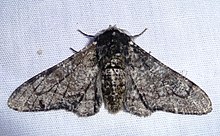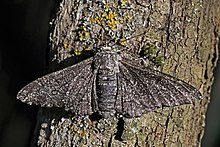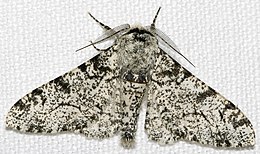Peppered moth
| Peppered moth | |
|---|---|

| |
| Male | |

| |
| Female | |
| Scientific classification | |
| Domain: | Eukaryota |
| Kingdom: | Animalia |
| Phylum: | Arthropoda |
| Class: | Insecta |
| Order: | Lepidoptera |
| Family: | Geometridae |
| Genus: | Biston |
| Species: | B. betularia
|
| Binomial name | |
| Biston betularia | |
| Subspecies | |
| |
| Synonyms | |
| |
The peppered moth (Biston betularia) is a temperate species of night-flying moth.[1] It is mostly found in the northern hemisphere in places like Asia, Europe and North America. Peppered moth evolution is an example of population genetics and natural selection.[2]
The caterpillars of the peppered moth not only mimic the form but also the colour of a twig. Recent research indicates that the caterpillars can sense the twig's colour with their skin and match their body colour to the background to protect themselves from predators.[3]
Description
[edit]The wingspan ranges from 45 mm to 62 mm (median 55 mm). It is relatively stout-bodied, with forewings relatively narrow-elongate. The wings are white, "peppered" with black, and with more-or-less distinct cross lines, also black. These transverse wing lines and "peppered" maculation (spotting) can also, in rare instances, be gray or brown; the spotting pattern, in particularly very rare cases, is sometimes a combination of brown and black/gray.[4] The black speckling varies in amount, in some examples it is almost absent, whilst in others it is so dense that the wings appear to be black sprinkled with white. The antennae of males are strongly bipectinate.[5][6] Prout (1912–16) gives an account of the forms and congeners.[7][8]
-
Biston betularia ♂
-
Biston betularia ♂ △
Distribution
[edit]Biston betularia is found in China (Heilongjiang, Jilin, Inner Mongolia, Beijing, Hebei, Shanxi, Shandong, Henan, Shaanxi, Ningxia, Gansu, Qinghai, Xinjiang, Fujian, Sichuan, Yunnan, Tibet), Russia, Mongolia, Japan, North Korea, South Korea, Nepal, Kazakhstan, Kyrgyzstan, Turkmenistan, Georgia, Azerbaijan, Armenia, Europe and North America.[9]
Ecology and life cycle
[edit]
In Great Britain and Ireland, the peppered moth is univoltine (i.e., it has one generation per year), whilst in south-eastern North America it is bivoltine (two generations per year). The lepidopteran life cycle consists of four stages: ova (eggs), several larval instars (caterpillars), pupae, which overwinter in the soil, and imagines (adults). During the day, the moths typically rest on trees, where they are preyed on by birds.
The caterpillar is a twig mimic, varying in colour between green and brown. On a historical note, it was one of the first animals to be identified as being camouflaged with countershading to make it appear flat (shading being the main visual cue that makes things appear solid), in a paper by Edward Bagnall Poulton in 1887.[11][12] Research indicates that the caterpillars can sense the twig's colour with their skin and match their body colour to the background to protect themselves from predators, an ability to camouflage themselves also found in cephalopods, chameleons and some fish, although this colour change is rather slower in the caterpillars.[3]
It goes into the soil late in the season, where it pupates in order to spend the winter. The imagines emerge from the pupae between late May and August, the males slightly before the females (this is common and expected from sexual selection). They emerge late in the day and dry their wings before flying that night.
The males fly every night of their lives in search of females, whereas the females only fly on the first night. Thereafter, the females release pheromones to attract males. Since the pheromone is carried by the wind, males tend to travel up the concentration gradient, i.e., toward the source. During flight, they are subject to predation by bats. The males guard the female from other males until she lays the eggs. The female lays about 2,000 pale-green ovoid eggs about 1 mm in length into crevices in bark with her ovipositor.
Resting behaviour
[edit]

A mating pair or a lone individual will spend the day hiding from predators, particularly birds. In the case of the former, the male stays with the female to ensure paternity. Evidence for resting positions is given by data collected by the peppered moth researcher Michael Majerus, and it is given in the accompanying charts. These data were originally published in Howlett and Majerus (1987), and an updated version published in Majerus (1998), who concluded that the moths rest in the upper part of the trees. Majerus notes:
Creationist critics of the peppered moth have often pointed to a statement made by Clarke et al. (1985): "... In 25 years we have only found two betularia on the tree trunks or walls adjacent to our traps, and none elsewhere". The reason now seems obvious. Few people spend their time looking for moths up in the trees. That is where peppered moths rest by day.
From their original data, Howlett and Majerus (1987) concluded that peppered moths generally rest in unexposed positions, using three main types of site. Firstly, a few inches below a branch-trunk joint on a tree trunk where the moth is in shadow; secondly, on the underside of branches and thirdly on foliate twigs. The above data would appear to support this.
Further support for these resting positions is given from experiments watching captive moths taking up resting positions in both males (Mikkola, 1979; 1984) and females (Liebert and Brakefield, 1987).
Majerus, et al., (2000) have shown that peppered moths are cryptically camouflaged against their backgrounds when they rest in the boughs of trees. It is clear that in human visible wavelengths, typica are camouflaged against lichens and carbonaria against plain bark. However, birds are capable of seeing ultraviolet light that humans cannot see. Using an ultraviolet-sensitive video camera, Majerus et al. showed that typica reflect ultraviolet light in a speckled fashion and are camouflaged against crustose lichens common on branches, both in ultraviolet and human-visible wavelengths. However, typica are not as well camouflaged against foliose lichens common on tree trunks; though they are camouflaged in human wavelengths, in ultraviolet wavelengths, foliose lichens do not reflect ultraviolet light.
During an experiment in Cambridge over the seven years 2001–2007 Majerus noted the natural resting positions of peppered moths, and of the 135 moths examined over half were on tree branches, mostly on the lower half of the branch, 37% were on tree trunks, mostly on the north side, and only 12.6% were resting on or under twigs.[13][14]
Polymorphism
[edit]Introduction on forms
[edit]There are several melanic and non-melanic morphs of the peppered moth. These are controlled genetically. A particular colour morph can be indicated in a standard way by following the species name in the form "morpha morph name". The use of "form" in the method of Biston betularia f. formname in detailing these variations is also a widespread practice.
These forms are often accidentally elevated to subspecies status when they appear in literature. Not adding the "f." (forma) or morpha implies that the taxon is a subspecies instead of a form, as in Biston betularia carbonaria instead of Biston betularia f. carbonaria. Rarely, forms have been elevated to species status, as in Biston carbonaria. Either of these two circumstances might lead to the erroneous belief that speciation was involved in the observed evolution of the peppered moth. This is not the case; individuals of each morph interbreed and produce fertile offspring with individuals of all other morphs; hence there is only one peppered moth species.
By contrast, different subspecies of the same species can theoretically interbreed with one another and will produce fully fertile and healthy offspring, but in practice do not, as they live in different regions or reproduce in different seasons. Full-fledged species are either unable to produce fertile and healthy offspring, or do not recognize each other's courtship signals, or both.
European breeding experiments have shown that in Biston betularia betularia, the allele for melanism producing morpha carbonaria is controlled by a single locus. The melanic allele is dominant to the non-melanic allele. This situation is, however, somewhat complicated by the presence of three other alleles that produce indistinguishable morphs of morpha medionigra. These are of intermediate dominance, but this is not complete (Majerus, 1998).
Form names
[edit]In continental Europe, there are three morphs: the white morph typica (syn. morpha/f. betularia), the dark melanistic morph carbonaria (syn. doubledayaria), and an intermediate form medionigra.
In Britain, the typical white morph is known as typica, the melanic morph is carbonaria, and the intermediate phenotype is named insularia.
In North America, the melanic black morph is morpha swettaria. In Biston betularia cognataria, the melanic allele (producing morpha swettaria) is similarly dominant to the non-melanic allele. There are also some intermediate morphs. In Japan, no melanic morphs have been recorded; they are all morpha typica.
Evolution
[edit]

The evolution of the peppered moth over the last two hundred years has been studied in detail. At the start of this period, the vast majority of peppered moths had light coloured wing patterns which effectively camouflaged them against the light-coloured trees and lichens upon which they rested. However, due to widespread pollution during the Industrial Revolution in England, many of the lichens died out, and the trees which peppered moths rested on became blackened by soot, causing most of the light-coloured moths, or typica, to die off due to predation. At the same time, the dark-coloured, or melanic, moths, carbonaria, flourished because they could hide on the darkened trees.[15]
Since then, with improved environmental standards, light-coloured peppered moths have again become common, and the dramatic change in the peppered moth's population has remained a subject of much interest and study. This has led to the coining of the term "industrial melanism" to refer to the genetic darkening of species in response to pollutants. As a result of the relatively simple and easy-to-understand circumstances of the adaptation, the peppered moth has become a common example used in explaining or demonstrating natural selection to laypeople and classroom students through simulations.[16]
The first carbonaria morph was recorded by Edleston in Manchester in 1848, and over the subsequent years it increased in frequency. Predation experiments, particularly by Bernard Kettlewell, established that the agent of selection was birds who preyed on the carbonaria morph. Subsequent experiments and observations have supported the initial evolutionary explanation of the phenomenon.[17][18][19]
Genetic basis of melanism
[edit]The evolution of the industrial melanism mutation has been shown to be due to the insertion of a transposable element into the first intron of the cortex gene, resulting in an increase in the abundance of the cortex transcript, which is expressed in developing wings.[20]
Gallery
[edit]-
Subspecies parva (male)
-
Subspecies parva (female)
-
Subspecies Biston betularia nepalensis (male)
-
Subspecies nepalensis (female)
References
[edit]- ^ Grant, Bruce S. (1999). "Fine tuning the peppered moth paradigm: Reviewed Work: 'Melanism: Evolution in Action' by Michael E. N. Majerus". Evolution. 53 (3): 980–984. doi:10.2307/2640740. JSTOR 2640740.
- ^ Gishlick, Alan (23 November 2006). "Icon 6 — Peppered Moths". National Center for Science Education. Retrieved 19 December 2009.
- ^ a b Eacock, A.; Rowland, H. R.; van’t Hof, A. E.; Yung, C.; Edmonds, N.; Saccheri, I. J. (August 2019). "Caterpillars of the peppered moth perceive color through their skin to match their body color to the background". Retrieved 2 August 2019.
- ^ "Photos of Peppered Moth (Biston betularia) · iNaturalist". iNaturalist. Retrieved 16 November 2020.
- ^ Richard South, 1909 The Moths of the British Isles Frederick Warne
- ^ Watson, L., and Dallwitz, M.J. 2003 onwards. British insects: the genera of Lepidoptera-Geometridae. Version: 29 December 2011
- ^ Prout, L. B. (1912–16). Geometridae. In A. Seitz (ed.) The Macrolepidoptera of the World. The Palaearctic Geometridae, 4. 479 pp. Alfred Kernen, Stuttgart.pdf
- ^ Pasi Sihvonen and Peder Skou , 2015 In: Axel Hausmann (Hrsg.):, 2015 The Geometrid Moths of Europe. 1. Auflage. Volume 5: Ennominae I, Stenstrup 2015, 978-90-04-26573-8
- ^ Jiang, N.; Xue, D.; Han, H. (2011). "A review of Biston Leach, 1815 (Lepidoptera, Geometridae, Ennominae) from China, with description of one new species". ZooKeys (139): 45–96. doi:10.3897/zookeys.139.1308. PMC 3260909. PMID 22259309.
- ^ Noor MA, Parnell RS, Grant BS (2008). Humphries S (ed.). "A Reversible Color Polyphenism in American Peppered Moth (Biston betularia cognataria) Caterpillars". PLOS ONE. 3 (9): e3142. Bibcode:2008PLoSO...3.3142N. doi:10.1371/journal.pone.0003142. PMC 2518955. PMID 18769543.
- ^ Poulton, Edward B. (October 1887). "Notes in 1886 upon Lepidopterous Larvae, etc". Transactions of the Entomological Society of London: 294.
- ^ Thayer, Gerald H. (1909). Concealing-Coloration in the Animal Kingdom. Macmillan. pp. 22.
- ^ Michael E. N. Majerus (August 2007). "The Peppered Moth: The Proof of Darwinian Evolution" (PDF). Archived from the original (PDF) on 15 June 2011. Retrieved 21 February 2011.
- ^ Connor, Steve (25 August 2007). "Moth study backs classic 'test case' for Darwin's theory". The Independent. Archived from the original on 7 October 2008. Retrieved 9 September 2007.
- ^ Ken Miller (August 1999). "The peppered moth: an update". Brown University.
- ^ "A modelling exercise for students using the peppered moth as its example" (PDF). Archived from the original (PDF) on 3 March 2016. Retrieved 27 April 2011.
- ^ Mark Isaak (2 May 2005). "The peppered moth story". TalkOrigins Archive. Index to Creationist Claims: CB601.
- ^ David Wilson (10 September 2003). "Dark moths increased in s. Britain after pollution control began". Index to Creationist Claims: CB601.2.3.
- ^ David Wilson (10 September 2003). "In several areas dark moths were more common than expected". Index to Creationist Claims: CB601.2.2.
- ^ Arjen E. van’t Hof, Pascal Campagne, Daniel J. Rigden, Carl J. Yung, Jessica Lingley, Michael A. Quail, Neil Hall, Alistair C. Darby & Ilik J. Saccheri (2016). "The industrial melanism mutation in British peppered moths is a transposable element". Nature. 534 (7605): 102–105. Bibcode:2016Natur.534..102H. doi:10.1038/nature17951. PMID 27251284.
{{cite journal}}: CS1 maint: multiple names: authors list (link)
External links
[edit]- Bruce Grant has written several papers on melanism in the peppered moth which are listed on his home page.
- Online lecture: "The rise and fall of the melanic Peppered Moth" presented by Laurence Cook.
- Matt Young. "Moonshine: Why the Peppered Moth remains an Icon of Evolution". Department of Physics, Colorado School of Mines. Retrieved 3 January 2009.
- The Peppered Moth: Decline of a Darwinian Disciple. This is the transcript of Michael Majerus' lecture delivered to the British Humanist Association on Darwin Day 2004.
- The Peppered Moth: The Proof of Darwinian Evolution. This is the transcript of Majerus' lecture given at the European Society for Evolutionary Biology meeting on 23 August 2007. The accompanying Microsoft PowerPoint presentation is also available as a pdf file.
- Majerus, Michael E. N. (6 December 2008). "Industrial Melanism in the Peppered Moth, Biston betularia: An Excellent Teaching Example of Darwinian Evolution in Action". Evolution: Education and Outreach. 2 (1): 63–74. doi:10.1007/s12052-008-0107-y.
Accusations of data fudging and scientific fraud in the case are found to be vacuous.
- An interactive game to simulate how evolution works with Biston betularia
- Wing vein patterns; this information is found in iNaturalist.org at Wiki - American Peppered Moths.






